Motor Sport
Where is Motorsport Currently Found on the EV Map?
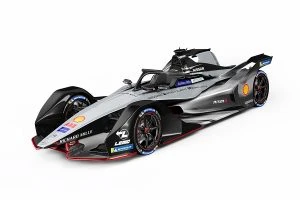
Formula E racing car.
Traditionally, the latest cutting-edge technology finds its way into road cars via the heat of motor racing. We are seeing EV racing going big quickly with the relatively recent Formula E championship, but how many motor racing championships are looking to EV technology for their future racing blue-print? As yet, EV motor racing technology hasn’t made its way into the everyday life of most average Australian motorists. Most of us still drive a motor vehicle with a healthy internal combustion engine, and most of us won’t be intending or even considering buying an expensive EV as an everyday means of transport anytime soon.
Supercars are continuing to investigate implementing hybrid technology into its racing schedule.
Formula One has had its engine regulations tweaked further with the aim of promoting closer racing and more balanced competition, as well as bringing economic and sporting sustainability to Formula 1. So, the cars are now flashier and more visually alluring, with the reshaping of the front and rear wings looking good. Formula One has a target to be net zero by 2030, and the way this is to be achieved is by removing single use plastics from its events, in collaboration with its circuits. Formula One won’t be going electric but will stay hybrid, and this has been a definite decision that the ‘powers that be’ have taken for the good of the automotive industry as they keep their racing car platforms relevant for future road cars. Formula One does not see electrification as the new world-religion, and it has stated that EVs are definitely not the only way to move forward with cars. Hybrid technology is Formula One’s current future objective, where the 2025 engine-unit will be hybrid and using 100 % sustainable fuels. Formula One sees a need to reduce the costs of this new engine-unit and platform so that it is affordable and less complex, which will open up huge potential for original equipment manufacturers (OEMs) to use in other applications for road cars.
In the World Rally Championship, current hybrid engine regulations from 2022 through to 2025 is all go, which introduces hybrid technology to the fastest cars on gravel. The hybrid technical regulations are a long way from being finalised, but initial talks have mooted a ‘supplementary hybrid system’ which controls components and software. The proposed hybrid units would allow WRC cars, which will retain the 2017 aero and engine package, to run as full EVs on transit stages, while providing a power boost on competitive special stages. Following 2025, the plan is to open up the rules to allow manufacturers to use their own electric systems for racing.
Formula E
Formula E is going from strength to strength, with Mercedes-Benz and Porsche recently joining the grid. Formula E, officially the ABB FIA Formula E World Championship, is a single-seater motorsport championship for electric cars (EVs). The series was conceived in 2011 in Paris. Formula E is the biggest motor racing event solely focussed on EV racing alone, where it is the proving ground and platform to test new ev technologies, drive development to the production line, and put more EVs on the road.
Using the sport as its showcase, the ABB FIA Formula E World Championship is sending the biggest message out to the world that may help alter perceptions and speed-up the switch to electric, in a bid to counteract the so-called “climate crisis” as well as addressing the effects of air pollution – particularly in cities. Sure, Formula E is the fastest-growing series in motorsport because its also the newest; however, it is certainly going to help put EV technology out there on the roads, even if most current EV buyers are either famous and or high-end earners.
Some electrification in motor racing is happening, where we’re seeing classes like the British Touring Car Championship, IndyCar, IMSA, NASCAR and World Rallycross Championship having some sort of hybrid or fully electric rules etched into the near-future pipeline. This is all good, but the reality is that most motorists in the general public will still be driving a car with a combustion engine, or combustion engine with hybrid technology, or a car with a combustion engine running on bio fuels in a decade because of the price of a new EV being way too steep, the lack of an EV infrastructure another, the cost of developing a country’s power grid worthy of supporting the power drain of a big EV fleet, EV battery life span, and the list goes on…
All of the many negative attributes that can be accredited to EVs aside, there are some fascinating new technological developments in hybrid and ev technology unfolding within motorsport itself.
Farewell To the Queen of the Nürburgring

As a female motoring blogger, I was very sorry to hear that one of my motoring heroines, Sabine Schmitz, passed away recently. It’s particularly poignant when I realized that she was only a few years older than me.
If you aren’t sure who I’m talking about, I’m referring to the German motor show presenter who appeared frequently on the British motoring show Top Gear. We first met her in a 2004 episode, where she became Jeremy Clarkson’s nemesis, as she was a German (groan!) woman (gasp!) who beat Jeremy Clarkson around the Nürburgring (ouch!) in a diesel (eek!) van (aaagh!). I know I definitely loved it when she made it around the Ring in less than 10 minutes. This wasn’t her first appearance on a Top Gear show (she appeared briefly in a 2002 special) and it wasn’t her last, either. In fact, after the ousting of the Unholy Trinity of Clarkson, Hammond and May, she was selected by the BBC as one of the new presenters.
Sabine was one of three daughters of restaurant owners who lived near the famous Nürburgring. She and her sisters all participated in motorsports, but she was the most successful of the three. During her racing career, she won the 24-hour Nürburgring challenge twice (both times in a BMW), as well as placing third, ninth and sixth in Porsches (if you’re looking it up, you’ll find her under her married name of Sabine Reck). She operated a “taxi service” professionally in the Nürburgring, and later added driver training to her company portfolio. It’s probably no exaggeration to say that she knew the Nürburgring ring like I know my neighbourhood roads. The track was her neighbourhood road.
As she was known not only for her driving skills but also for her sparkling personality, she appeared frequently on the German equivalent of Top Gear, a show called D Motor. She also provided commentary for motorsports from time to time, becoming known for her sense of humour.
I always enjoyed watching the episodes of Top Gear when she appeared, and it was fantastic to see a woman succeeding in what has traditionally been a very male-dominated area – which is odd, when you come to think about it, given that it was a German woman, Bertha Benz, who brought the motorcar to public attention in the first place. She was a great role model for girls learning to drive and showed the public that driving well is not necessarily a “boy thing”.
She was, unfortunately, diagnosed with a very aggressive cancer in 2017, although this was not made public until last year. She fought it hard, but lost the battle a few weeks ago. I’m sure I won’t be the only one who misses her and will be disappointed not to see any more of her.
One more time, let’s enjoy one of her iconic Nürburgring laps in a van for Top Gear that we loved so much:
<iframe width=”560″ height=”315″ src=”https://www.youtube.com/embed/5KiC03_wVjc” title=”YouTube video player” frameborder=”0″ allow=”accelerometer; autoplay; clipboard-write; encrypted-media; gyroscope; picture-in-picture” allowfullscreen></iframe>
Aussie’s Rosco aiming for 1000 mph
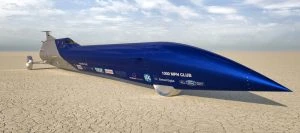
Aussie Invader 5R
It might be a bit hard to call it a conventional car but then it’s not really a conventional car in the sense that the Aussie Invader 5R rocket-car looks more plane/rocket in its appearance. The Aussie Invader 5R rocket-car boasts an insanely long arrow-shaped design with three wheels, large aerodynamic wind deflectors and an engine with close to 150,000 kW! Yes, that’s correct; you did read that figure correctly. To put that in perspective, an Aussie V8 Supercar puts out, on average, around 475 kW of power. Now, if you’ve ever experienced the wonderful roar of these V8s when they blast by around the circuit, then you can understand the aura of such kW potency. But this Aussie Invader 5R rocket-car makes as much power as 316 of these Aussie V8 Supercars put together! The Aussie Invader 5R rocket-car is powered by a single bi-propellant rocket reportedly capable of producing upwards of 62,000 lbf of thrust. That’s over four times more than a Boeing 737 jet!
Founder and designer of the new Aussie Invader 5R rocket-car, Rosco McGlashan, has the world’s fastest land speed record in his sights. He will reportedly be the pilot of the 16-metre long, nine-tonne steel-framed vehicle. And the target? The target top speed of 1609 km/h (1000 mph) would be the fastest of any land-going vehicle, ever. And 1000 mph would see it blitz the current land speed record held by the Noble Thrust SSC on a Nevada salt flat in 1997, which averaged 1223.7 km/h and broke the sound barrier while doing so.
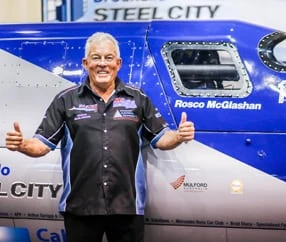
Rosco McGlashan
Rosco McGlashan would like to set the new record next year once all the Covid palaver is over-and-done-with, and it will likely be set somewhere in the Queensland or Western Australian desert. Rosco is no stranger to setting speed records; he is already the holder of the Australian land speed record, where in 1994 he clocked 802.6 km/h behind the wheel of a jet-powered predecessor to the Aussie Invader 5R out on the dry salt flats of Lake Gairdner, near Adelaide. He has, after all, built all of his drag racing, exhibition, and land-speed racing vehicles himself over the years in a shed at his home.
Rosco has accurate computer modelling on the Aussie Invader 5R rocket-car, which suggests that the Aussie Invader 5R rocket-car will have enough power and thrust for launching the car from 0-100 km/h in approximately 1.1 seconds. It should reach its target of 1000 mph in less than 30 seconds. Slowing the Aussie Invader 5R rocket-car down is no mean feat and will thus will require a full 13 km of flat desert just to stop it. A multi-stage deployment of high-speed hydraulic air brakes, mid-speed parachutes, and low-speed disc brakes have been designed to activate progressively to safely bring the vehicle to a halt.
Picking an exact location will depend largely on which organization or individual steps up as the primary sponsor for the effort. As will the practical necessity of having 5 km of flat desert for getting up to speed plus another 13 km to stop it.
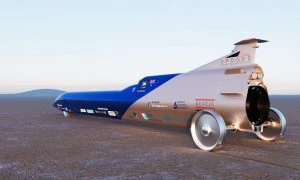
Aussie Invader 5R
Mini’s Hot Secret!
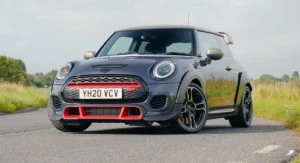
MINI JCW GP
There is one other Mini that might have flown in under your radar. It is the wildest Mini hot hatch yet, and it’s called the Mini John Cooper Works GP. The car looks really cool and boasts the highest price tag of any Mini yet – but for good reason.
It was built as a JCW GP 60th year birthday present for Mini, and it sits low down on a 40 mm wider track. The massive grille, bold GP badge, massive front spoiler and two large air foiling scoops just give the car a special presence that is brutal and focused. The air intake slot in the bonnet is large and ready to suck in gallons of air to help spool the turbo.

Look at the Mini JCW GP hot-hatch side on, and the chunky styling looks awesome, mean and racy. It features huge wheel arches, massive side skirts and an enormous spoiler. The car is also lower than standard JCW cars.
Head around the back, and you note that the spoiler has also been skilfully incorporated into the roof guttering showing a nice level of attention to detail. The taillights have been darkened and the twin exhaust outlets poke aggressively out from the centre of the rear skirt. These crackle and pop with full throttle and under serious braking. What a car!
Inside, the racy Mini JCW GP is fairly simple. It boasts nice leather bucket seats, a digital dash, 3-D printed panels with an array of options for logos and displays. A special ‘GP pack’ adds all the comfort and bells and whistles like heated seats and dual zone climate control, but remember this is a stripped out limited edition racer that comes standard with just the two seats. A horizontal strut brace takes up where the rear seats would normally sit.
So just 3000 units will be made worldwide, and 65 of those will make the journey to Australia – and they have almost certainly already been sold to their lucky owners. They are around $12,500 more expensive than a ‘regular’ John Cooper Works, so I’d imagine if you did own one and tried to sell it now, you could fetch even more than the original price.
The Mini JCW GP is significantly more expensive than more generously equipped hot hatch rivals such as the Volkswagen Golf R ($56,990); but who cares – the car is a phenomenal performer and it is a limited edition. The new John Cooper Works GP is driven by a special version of BMW’s 2.0-litre turbo engine with an output of 225 kW of power and 450 Nm of torque available. Just the eight-speed automatic with paddle shifters is available, however this set-up ensures that the power is delivered precisely on time – every time. Mini has developed a unique suspension for the GP, designed to make it even faster around a racetrack than the standard JCW Hatch. Mini claims the FWD JCW GP hot-hatch will do the 0-100 km/h dash in just 5.2 seconds. This is just the start of the rush of power and acceleration that goes on to a governed top speed of 265 km/h. This is very quick indeed! The FWD power is controlled with a limited slip-diff.
You’ll want to keep your ear to the ground and see if you can find a seller of the wonderful little Mini JCW GP ‘hottie’. It’s distinctively different and extremely aggressive, and you’re in for a thrilling and wild ride.
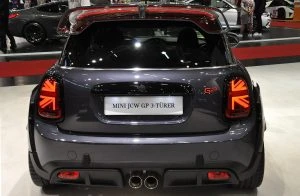
Mini’s Hottest Hatch